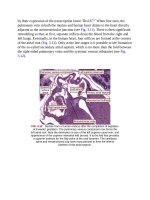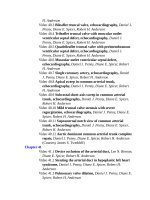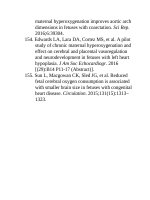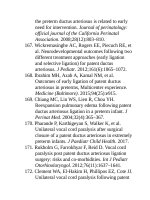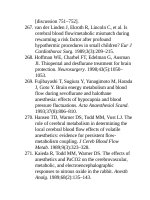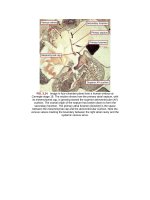Andersons pediatric cardiology 1114
Bạn đang xem bản rút gọn của tài liệu. Xem và tải ngay bản đầy đủ của tài liệu tại đây (122.18 KB, 3 trang )
haslessclinicalrelevancetoday,whentransthoracicechocardiographyis
routinelyusedtofollowandevaluatepatientswithpulmonaryvalvestenosis.
Rudolfproposedthat,inchildren,thevoltageofapureRwaverecordedatV1
correlateswithapproximately20%oftherightventricularpressure.25Itturns
outthattheQRSaxismaybeamorereliableindicatorofrightventricular
pressure.26Indeed,thepredictionofrightventricularpressuregradientis
optimizedbyuseofanumberofvariablesinadditiontothemeasurementsof
voltageontheECG,asproposedbyEllison,27asfollows:
Theclinicalscoreincludedpresenceofcyanosis,worth25;pulmonary
componentofthesecondsound,worth15ifdiminished(or25ifinaudible);a
QRSaxisofgreaterthan90degrees,worth10;negativeTwavesinaVFandV1,
worth35;andRV1above10mmworth15.Thiscomplexformulahasbeen
supersededbythequicker,moreaccurate,andmorereliableuseofDoppler
echocardiography.
ChestRadiograph
Thechestradiographshowsthefeaturesofrightventricularhypertrophyand,if
present,poststenoticdilationofthepulmonarytrunk.Rightventricular
hypertrophyisseenasanupturnedcardiacapex.Thedilatedpulmonarytrunkis
seenasaprominenceoftheleftupperheartborder,inferiortotheaorticknuckle
(Fig.42.12).Rightatrialenlargementcausesamorepronouncedconvexityof
therightlowerheartborder.Althoughitisimportanttoknowthosefindings,a
routinechestradiographisusuallynotindicatedintheevaluationofpatients
withpulmonaryvalvestenosis.
FIG.42.12 Frontalchestradiographofmildpulmonarystenosisshowing
aprominentpulmonarytrunkwithoutfeaturesofrightventricular
hypertrophy.
Echocardiography
Thegoldstandardinvestigationfortheassessmentofthemorphologyof
pulmonarystenosisiscross-sectionalechocardiographycoupledwithDoppler
analysisoftheflowintherightventricularoutflowtractandpulmonaryarteries.
Advantagessuchaswidespreadavailabilityandlackofadversesideeffectshave
helpedmakeechocardiographytheprimaryimagingmodalitybywhich
pulmonarystenosisisdiagnosedandmanaged.
Cross-sectionalechocardiographywilldefinewhethertheobstructionisatthe
levelofthevalvarleaflets(Fig.42.13;Video42.1)orsubvalvar(Fig.42.14)or
supravalvar(Fig.42.15).Thepresenceandseverityofrestrictedmotionofthe
leafletsaswellasdysplasiacanreadilybeassessed,alongwithanypoststenotic
dilationofthepulmonarytrunk(Fig.42.16).Thediameterofthepulmonary
valveatthehemodynamicventriculoarterialjunctioncanbemeasuredaccurately
(Fig.42.17),facilitatingtheplanningofintervention.Attemptshavebeenmade
toquantifythesemethods,withrecommendationsbeingpublishedonhowto
measurethepulmonaryoutflowtractsandsemilunarvalvesinthepediatric
population.Specifically,thepulmonaryvalveannulusshouldbemagnifiedinthe
parasternallong-orshort-axisviewandmeasuredbetweentheinneredgesofthe
hingepointsinmidsystole.28Althoughroutinelydoneinvalvarpulmonary
stenosis,echocardiographicmeasurementofthepulmonaryvalveannulusdoes
notprecludetheneedtomeasurebyangiographyduringintervention,as
echocardiographicmeasurementappearstounderestimateannularsize.29
FIG.42.13 Two-dimensionalimageofthepulmonaryvalveinthe
parasternalshort-axisviewfromapatientwithvalvarpulmonarystenosis.
Notethethickenedleaflettipsofthepulmonaryvalve.
